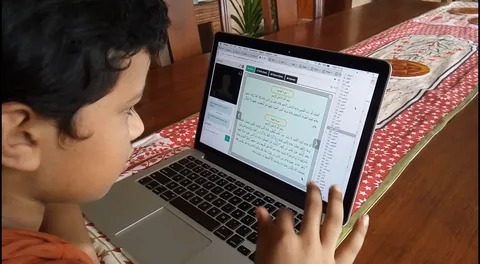In the vast ocean of Islamic knowledge, one aspect that holds profound significance is learning Tagweed in the Quran. Tagweed, also known as Tajweed, is the art of perfecting the pronunciation and recitation of the holy Quran. The Quran, being the ultimate guidance for Muslims, demands utmost reverence and precision in its recitation. In this article on Arabian Tongue website, we will explore the importance of Learn Tagweed Online, the benefits it brings to both spiritual and linguistic development, and how to access online resources to embark on this beautiful journey.
Meaning of the Tagweed
Tagweed, derived from the Arabic root “J-W-D,” meaning “to make better” or “to improve,” encompasses the set of rules and principles governing the correct pronunciation of Arabic letters, proper articulation of words, and appropriate pauses during Quranic recitation. By adhering to Tagweed, the words of the Quran resonate with elegance, clarity, and melodious beauty.
The Importance of Learning Tagweed

In order for the Qur’an and religious concepts to learn correctly and to clean the Qur’an well, you must understand the meaning of the improvement and its importance in preserving and understanding the Qur’an as follows:
The Spiritual Connection
Learning Tagweed is not merely an academic pursuit; it is an act of worship and devotion. Muslims believe that the Quran is the literal word of Allah (God), and its recitation holds immense spiritual benefits. Embracing Tagweed instills a profound sense of tranquility, humility, and closeness to the Almighty, as one delves into the profound meanings and teachings of the verses.
Preserving the Quran’s Originality
The meticulous preservation of the Quran over the centuries is nothing short of miraculous. The science of Tagweed plays a pivotal role in safeguarding the originality of the Quranic text. By following the rules of Tagweed, Muslims ensure that the sacred scripture remains free from any alteration or misinterpretation, passing down the divine message intact from generation to generation.
Enhancing Linguistic Proficiency
The study of Tagweed fosters a deep appreciation for the intricacies of the Arabic language. As learners engage with the subtle nuances of pronunciation and articulation, they sharpen their linguistic skills. This, in turn, enriches their understanding of the Quran’s linguistic marvels, elevating their command over Arabic and opening doors to other areas of literature and culture.
Book Now: Arabic grammar course online for beginners.
Embodying Reverence and Gratitude
Learning Tagweed is an act of gratitude towards Allah for granting access to His divine words. It reflects an earnest desire to approach the Quran with the respect and dignity it deserves. By striving to recite the Quran with excellence, Muslims embody their reverence for Allah and His boundless wisdom.
Advantages of learning Tagweed online
Online learning courses have helped many Muslims who want to learn the Qur’an with all its concepts correctly and one of the most prominent advantages of learning Tagweed online:
Online Resources and Courses
The digital age has brought unprecedented opportunities for knowledge dissemination, and learning Tagweed is no exception. Various online platforms and educational websites offer comprehensive Tagweed courses, catering to learners of all ages and levels of expertise. These courses often include audio and video demonstrations, interactive exercises, and live sessions with qualified instructors.
Flexibility and Convenience
One of the significant advantages of online Tagweed courses is the flexibility they offer. Learners can access the materials and lectures at their convenience, enabling them to balance their study with other commitments. Whether it’s a busy professional or a student, online learning makes it feasible for anyone to embark on this transformative journey.
Community Engagement
While online learning might seem isolated, many platforms foster a sense of community among learners. Discussion forums, group sessions, and social media groups allow students to interact, exchange knowledge, and seek guidance from fellow learners and experienced teachers, creating a supportive ecosystem for growth.
Spiritual Connection with the Quran
Tajweed fosters a deep spiritual connection with the Quran, enhancing the reader’s sense of spirituality and devotion, Increased Understanding and Comprehension Proper pronunciation and recitation aid in better understanding the meaning and context of Quranic verses.
Enhanced Memorization
Tajweed facilitates memorization by making the Quranic verses more melodious and easier to recall, Improved Recitation
Mastering Tajweed improves the quality of recitation, making it more pleasant and eloquent.
Learn Now: learn Online Quran Memorization Course.
Tajweed and Tajwid: Understanding the Difference
Tajweed and Tajwid are sometimes used interchangeably, but they have distinct meanings. While Tajweed refers to the rules and mechanics of Quranic recitation, Tajwid focuses on the aesthetics and beautification of the recitation.
Basics of Tajweed

To begin learning Tajweed, one must master the foundational principles, which include:
- Proper Pronunciation: Clear and accurate pronunciation of each Arabic letter is crucial in Tajweed. The smallest mispronunciation can change the meaning of a word or verse entirely.
- Correct Articulation Points: Each Arabic letter has a specific point of articulation, and learning these points ensures precise pronunciation.
- Lengthening and Shortening of Sounds: Tajweed governs how certain letters and sounds should be prolonged or shortened, adding rhythm and beauty to the recitation.
- Pauses and Stops: Learning where to pause and stop during recitation is essential for proper fluency and understanding.
- Characteristics of Letters: Each Arabic letter possesses unique characteristics that affect its pronunciation and interaction with adjacent letters. Understanding these characteristics is crucial to recite the Quran accurately.
- Rules of Noon Sakinah and Tanween: The rules governing the pronunciation of Noon Sakinah and Tanween (nunation) are essential to create a harmonious flow in the recitation.
- Rules of Meem Sakinah: Similar to Noon Sakinah, Meem Sakinah has specific rules that govern its pronunciation and merging with the following letters.
Book Now: Arabic Language Kids Course.
Tajweed Rules and Categories
Tajweed rules are divided into various categories, each addressing specific aspects of recitation. Some of these include:
- Rules of Noon and Meem Mushaddad: These rules deal with the pronunciation of the letters “noon” and “meem” when accompanied by shaddah (double consonant).
- Rules of Madd (Lengthening): Madd involves elongating certain vowels within words to create a harmonious flow while reciting.
- Rules of Raa and Laam: These rules address the proper pronunciation of the letters “raa” and “laam,” which can have variations based on their location within a word.
- Rules of Qalqalah: Qalqalah refers to the echoing or bouncing sound produced by certain Arabic letters. The rules specify when and how to apply this effect.
- Rules of Idgham: Idgham deals with the blending of two Arabic letters in specific situations, merging the pronunciation smoothly.
- Rules of Ghunnah: Ghunnah involves nasalizing specific letters in the Quran, adding a unique sound to the recitation.
Tajweed Rules of Noon Saakin and Tanween

Tajweed is an essential aspect of reciting the Quran with proper pronunciation and rules. One of the most important aspects of Tajweed is understanding the rules of Noon Saakin and Tanween. These rules govern the proper pronunciation of the letter Noon with a diacritic mark (Saakin) and when it carries the short vowels (Tanween):
Understanding Noon Saakin
Noon Saakin refers to the letter Noon with a diacritic mark (a small circle) on top of it. When Noon Saakin appears at the end of a word and is followed by a pause or a specific type of consonant, certain rules come into play.
Book Now: Islamic Studies Course Online For Kids.
1. Idghaam
Idghaam is a Tajweed rule that applies to Noon Saakin followed by the letters of Meem (م) and Noon (ن). In this case, the sound of Noon Saakin is merged or assimilated into the sound of the subsequent letter. There are two types of Idghaam:
a. Idghaam with Ghunnah
In this type of Idghaam, the sound of Noon Saakin is merged into the sound of Meem or Noon with a nasal sound (Ghunnah). The reader should maintain the nasal sound for two counts. Example: The word “من” is recited with a nasal sound when followed by a word starting with a vowel, like “من يأتي.”
b. Idghaam without Ghunnah
In this type of Idghaam, the sound of Noon Saakin is merged into the sound of Meem or Noon without producing a nasal sound. Example: The word “من” is recited without a nasal sound when followed by a word starting with a consonant, like “من بعد.”
2. Ikhfa
Ikhfa is a Tajweed rule that applies to Noon Saakin followed by the letters of Ba (ب), Jeem (ج), Dal (د), and other similar letters. In Ikhfa, the sound of Noon Saakin is subtly merged with the sound of the subsequent letter without a distinct pause or Ghunnah.
Understanding Tanween
Tanween refers to the short vowels (Fat-ha, Kasrah, and Dammah) that appear on top of the letter Noon. When Tanween appears on Noon, certain Tajweed rules apply.
- Izhar: Izhar is a Tajweed rule that applies to Tanween when it comes before any of the letters of Al-Jahr (ا, ح, خ, ح, غ, ق, ع). In Izhar, the Tanween is pronounced clearly without any assimilation.
- Ikhfa: Similar to the Ikhfa rule for Noon Saakin, Ikhfa also applies to Tanween when it comes before the letters of Al-Ikhfa (ب, ج, د, ط, ت, ث, and so on). In Ikhfa, the Tanween is merged subtly with the sound of the subsequent letter.
- Idghaam: Idghaam applies to Tanween when it comes before the letters of Al-Idghaam (م, ن). The Tanween is assimilated into the sound of Meem or Noon with or without Ghunnah, depending on the specific letters that follow.
Learn Now: Reading Arabic online for Adults.
Understanding Iqlab in Tajweed
Iqlab is a Tajweed rule that occurs when the Arabic letter “Ba” (ب) appears with a sukoon (a diacritical mark indicating a stop) followed by the letter “Alif” (ا). In this case, the pronunciation of the “Ba” changes into a nasal sound similar to the English letter “M.”
Rules of Iqlab
The rule of Iqlab is straightforward – when encountering the “Ba” with a sukoon, the reciter must replace the sound of “Ba” with the sound of “Mim” (م) while maintaining the nasal tone. This rule applies only when the letter “Ba” is followed by an “Alif.”
Articulation Points in Iqlab
In Tajweed, proper pronunciation is crucial to preserve the integrity of the Quranic text. Iqlab involves specific articulation points, primarily focusing on the letter “Ba” and its transformation into the nasal “Mim” sound.
The letter “Ba” and “Alif” after it
The letter “Ba” (ب) is pronounced as a voiced consonant with the lips coming together. However, in the context of Iqlab, when a sukoon is placed on “Ba” followed by an “Alif” (ا), the reciter should convert the sound into a nasal “Mim” (م) sound.
Examples of Iqlab in the Quran
Several verses in the Quran exemplify the Iqlab rule, such as in Surah Al-Fatihah (1:7):
“۞ مَالِكِ يَوْمِ الدِّينِ”
The word “مَالِكِ” (Maaliki) demonstrates Iqlab, where the “Ba” followed by an “Alif” changes to the nasal “Mim” sound.
Learn Now: Quran Recitation online Course For Kids.
Makharij Al Haruf in Tajweed: Understanding the Articulation Points of Arabic Letters

Makharij Al Haruf is a foundational aspect of Tajweed, as it focuses on the exact points of articulation for each Arabic letter. Understanding these points is crucial for producing the correct sounds and avoiding pronunciation errors while reciting the Quran.
- Throat (Makhraj Al Halaq): The throat serves as the point of origin for letters such as “ح” (Ha), “ع” (Ain), and “هـ” (Haa).
- Tongue (Makhraj Al Lisan): The middle of the tongue touches the upper part of the mouth to articulate letters like “ط” (Taa), “د” (Dal), and “ر” (Ra).
- Lips (Makhraj Al Shahm): The lips are used to produce sounds for letters like “ب” (Ba), “ف” (Fa), and “و” (Wow).
- Nasal Passage (Makhraj An Nasal): The nasal passage is involved in the pronunciation of letters like “م” (Meem), “ن” (Noon), and “ا” (Alif) when followed by certain letters.
Characteristics of Each Articulation Point
- Throat (Makhraj Al Halaq): The letters originating from the throat have a deep and heavy sound. Properly pronouncing these letters adds a distinct quality to Quranic recitation.
- Tongue (Makhraj Al Lisan): Letters articulated with the tongue produce a crisp and clear sound. Mastering these sounds is essential for maintaining clarity in the recitation.
- Lips (Makhraj Al Shahm): Letters produced with the lips are light and have a popping sound. Paying attention to lip position is crucial for accurate pronunciation.
- Nasal Passage (Makhraj An Nasal): Letters articulated through the nasal passage have a resonant and melodious quality. Proper control is necessary to achieve the desired effect.
Learn Now: learn quran reading basics online course.
Benefits of Taking a Tajweed Course:
Enrolling in a Tajweed course offers several benefits, including:
- Improved Quranic recitation skills.
- Increased spirituality and connection with the Quran.
- Ability to teach Tajweed to others.
- Enhanced understanding of Arabic phonetics.
Tips for Effective Tajweed Learning
Learning Tajweed effectively requires dedication and practice. Here are some tips to enhance your learning experience:
- Consistency and Practice: Regular practice is key to mastering Tajweed. Consistency helps reinforce your knowledge and improves your recitation skills.
- Recording and Listening to Yourself: Recording yourself while reciting allows you to identify areas that need improvement. Listening to the recordings helps you gauge your progress.
- Seeking Feedback and Guidance: Seek guidance from experienced Tajweed instructors or knowledgeable individuals who can provide valuable feedback.
- Reciting with Tajweed in Prayer: Incorporate Tajweed in your daily prayers to reinforce your learning and experience the spiritual connection with the Quran.
The Role of Technology in Online Tajweed Lessons
Technology plays a crucial role in enhancing the online Tajweed learning experience. Various digital tools and platforms have been integrated to create interactive and engaging learning environments.
Interactive Learning Platforms
Online Tajweed lessons utilize interactive platforms that provide multimedia resources, quizzes, and assessments. These platforms enable students to actively participate in their learning journey and reinforce their understanding.
Video Conferencing and Webinars
Live video conferencing and webinars enable real-time interaction between students and teachers, replicating the traditional classroom experience. Students can receive personalized feedback and guidance from instructors.
Mobile Applications for Tajweed
Mobile applications have transformed how people access Tajweed lessons. With dedicated apps, students can learn on the go, practice their recitation, and track their progress conveniently.
Book Now: Online Arabic Classes.
Gamification and Learning Engagement
Incorporating gamification elements in online Tajweed lessons enhances the learning experience. Gamified learning platforms use rewards, badges, and challenges to motivate and engage learners, making the process enjoyable.
Customized Learning Experience
Technology allows personalized learning experiences. Students can focus on specific Tajweed rules they find challenging, tailoring the curriculum to their needs.
Virtual Practice Sessions
Online Tajweed lessons provide virtual practice sessions, where students can recite verses and receive instant feedback from virtual tutors, helping them refine their recitation skills.
Tracking Progress and Improvement
Technology enables the monitoring of individual progress and improvement. Students can assess their performance, identify areas for enhancement, and track their journey toward mastery.
Overcoming Linguistic Barriers
Online Tajweed lessons cater to diverse linguistic backgrounds. Translations and multilingual support make the learning experience inclusive and accessible to learners worldwide.
Preserving the Essence of Tajweed
Despite the technological advancements, online Tajweed lessons prioritize preserving the essence and sanctity of Tajweed. The focus remains on instilling reverence and respect for the Quran.
FAQs
Is learning Tagweed mandatory for Muslims?
Learning Tagweed is not obligatory, but it is highly recommended for those who wish to recite the Quran with perfection and spiritual depth.
Are online Tagweed courses suitable for beginners?
Absolutely! Online Tagweed courses cater to learners of all levels, from beginners to advanced students, providing step-by-step guidance.
Can non-Arabic speakers learn Tagweed?
Yes, non-Arabic speakers can learn Tagweed too. Many online courses offer transliterations and translations to aid learners.
How long does it take to master Tagweed?
The time to master Tagweed varies from person to person, depending on their dedication, practice, and prior knowledge of Arabic.
Is Tagweed limited to Quranic recitation only?
While Tagweed is primarily associated with Quranic recitation, its principles can also be applied to other forms of Arabic literature and poetry.
Conclusion
In conclusion, learning Tagweed online in the Quran is a profound endeavor that not only enhances the recitation skills of Muslims but also deepens their spiritual connection with the divine words. The art of Tagweed preserves the sanctity of the Quran and allows Muslims to approach it with humility and awe. Through online resources and courses, this transformative journey becomes accessible to seekers worldwide, ensuring that the beauty of the Quran’s recitation resonates across borders and languages.
